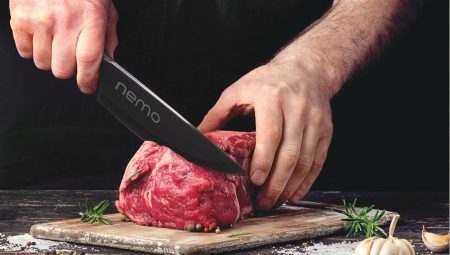Chefs pay great attention to the knives with which they work. For them, a quality knife is not a luxury, but the key to quick and professional cooking. A good knife will be a great helper not only in the restaurant's kitchen, but also at home. Therefore, you should not choose a cheap option at the nearest bazaar. A correctly selected knife will serve you for many years without losing its attractive appearance and its properties.
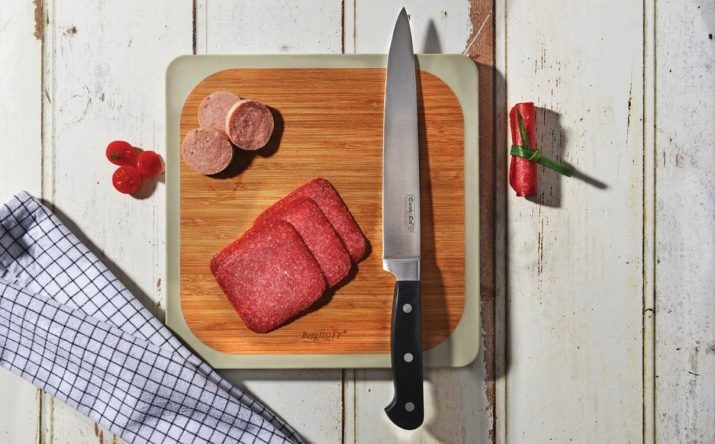
Distinctive features
To begin with, for almost every type of work it is better to get a separate knife. Do not be alarmed, there will not be so many. This will allow you to cut and process products with high quality, while the necessary hygiene standards will be observed. The meat knife is designed for rough work, so it cannot be small and thin. It should easily deal with slicing raw meat.
At the same time, one should not expect that he will be able to cut large bones.
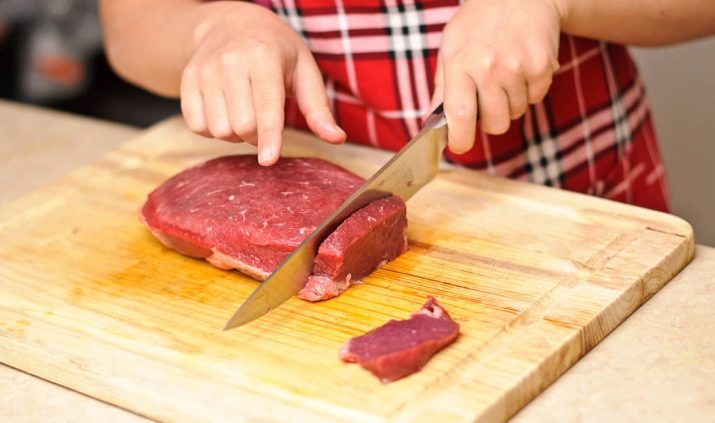
For these purposes, there is a separate category of cleaver knives. If you can’t imagine what a perfect meat knife should look like, then familiarize yourself with its features. This will help you make the right choice when buying and pay attention to important details.
- Meat knife is a classic model of a kitchen knife with a rather massive handle and blade. A distinctive feature is the presence of a recess on the handles. It is necessary so that the palm does not slide to the blade during operation. Raw meat is not so easy to cut, and therefore, with a certain pressure, slipping can lead to injury.
- Working with coarse fiber requires certain characteristics from the tool. One of the most important will be a rather thick blade.When slicing or boning, it should not bend.
- As for the drawing, it is completely absent on the blade itself. Its surface should be smooth, without any nicks. Also, knives with teeth will not work for this type of work.
- The handle is quite massive. This is logical in the presence of a rather thick blade. It can be made of quality plastic or wood. Metal handles during meat processing are not doing their best, so experts recommend giving up this choice.
- The blade itself must be made of durable material. After all, often they are not just cut, but hit on a piece of meat. At the moment, there is a wide variety of high-strength metal blades, but high-carbon steel knives remain favorites.

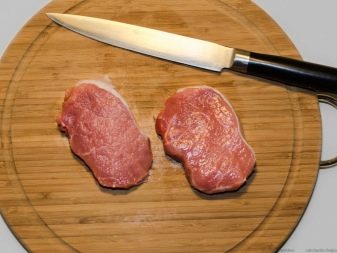
As it becomes clear from the summation of all the features of knives for cutting, they must be massive, durable, but at the same time convenient and easy to use.
Varieties
There are several types of knives for working with meat. It is not necessary to purchase all of them. But even having a few basic ones will greatly facilitate the cooking process.
- Hatchet ax. The most massive and largest knife. Blade sizes range from 450 to 500 mm. It is with this knife that carcasses are cut. But even if you do not do this at home, then the need to cut large pieces still periodically arises. It is a hatchet, the blade is large, almost rectangular. The blade is below the handle line, protruding strongly downward. Due to its size, it is not always convenient for women. It is rather a male tool.
But also chopping large pieces of meat or carcasses is also not entirely female.
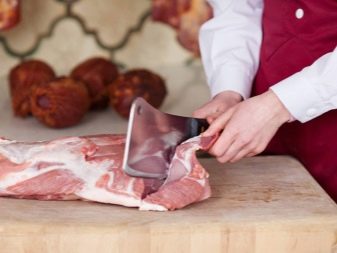

- Boning. This knife is very convenient to remove meat from the bone. Its feature is a thin and rather flexible blade. It has a slight rounding, which favorably affects the cutting ability. Since the separation of meat from bone is not an easy process, and you have to work in different directions, special attention is paid to the handle. She should ideally lie in a hand. This simplifies work, minimizes the risk of slipping and getting cuts.
A huge plus is the versatility of this model. It can also be used for shredding other products.
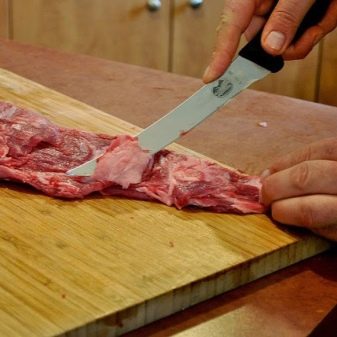

- Universal. This classic knife model that can be found in almost every home. The length of the blade is average (about 15 cm), its thickness is also close to the average parameters (1.5-2 mm). With this knife, you can perform almost any type of work. But practice shows that this is not so convenient. Nevertheless, the use of specialized kitchen accessories for chopping and boning meat several times simplifies the whole process.
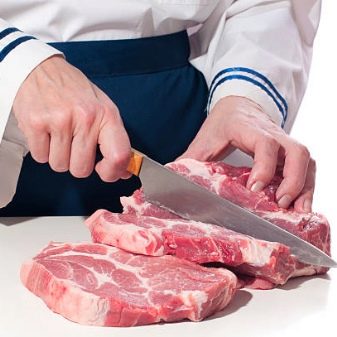
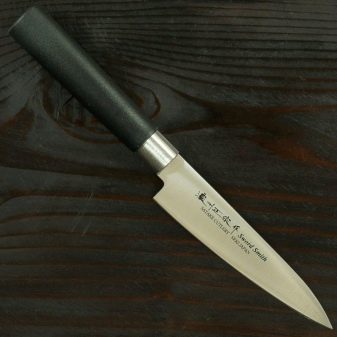
- Loin. Perhaps the thinnest and most elegant meat knife. Its original purpose was thin slicing of loin. But cooks and ordinary housewives quickly realized that it was very convenient for them to make thin slices from other products. Therefore, today it is often used to cut cheese, bacon or vegetables beautifully and finely. The length of the blade has a wide range and depends on how big a piece of fillet you need to cut. Knives with a blade of 15 cm are suitable for chicken and small pieces. But you can also find knives with a rather long blade of 36 cm.
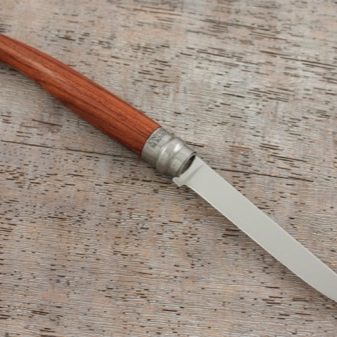
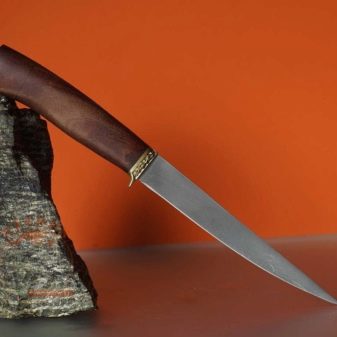
- Scimitar. A knife with a rather massive handle and blade, but at the same time thin and curved. Notches can be made on the blade. A slight bend makes it look like a saber. Despite this sophisticated look, the knife belongs to the category of universal. It can be used for chopping, slicing, chopping minced meat, except for boning meat and cutting offal.
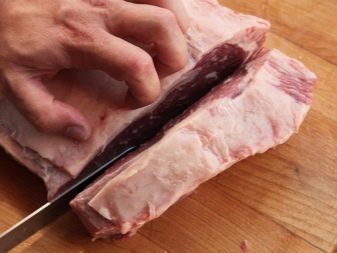

- Steak. A small knife with a rather thin but durable blade. The upper line of the blade is straight, the lower one is smoothly rounded towards the end. The small size and sharp blade of the steak knife allow you to make the perfect portioned slices and enjoy a juicy piece of meat without any difficulty.There are other varieties of knives for working with meat. For example, the unique giymyakesh used in the preparation of kebab, or the butcher’s knife, which is a necessary attribute of the real representatives of this profession, as well as the famous Turkish satyr.
But they all have a rather narrow specialization, and therefore are not necessary for acquiring home.
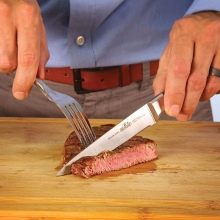
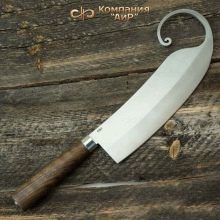
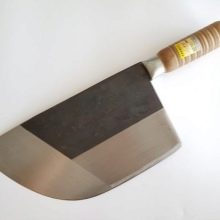
Top brands
There are a lot of manufacturers of knives, so listing them all is simply impossible. We will introduce you to the most worthy representatives.
- Fiskars. Stainless steel and soft quality plastic on the handle.
- Rondell Flamberg. Choose large models with double-sided sharpening.
- Grand High-quality knives that have proven their worth in the market.
- OPINEL Parallele. Stainless steel and a wooden handle make these knives versatile.
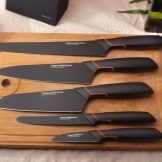

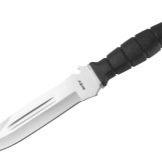

How to choose?
The choice of knife must be approached consciously. The convenience of cooking and the life of the selected instance will depend on this. If you do not want to "throw money away" and wonder every year, "which knife to buy this time," then remember the parameters on which your choice should be based.
Material
Currently, manufacturers give us a wide selection of knives. The material of the blade itself can be different. Each of them has its pros and cons.
- Ceramics. At first glance it seems that this material is perfect in every way. It is hygienic, the surface of the blade will not absorb odors. In addition, bacteria will not multiply on it. The material is very durable. And what is especially valuable, it can be sharpened to the desired sharpness of the blade. But if we talk about the daily use of such a knife, then problems may arise. Ceramics do not tolerate sudden changes in temperature.
Strong impacts can also cause her irreparable damage. And even strength has a negative side. Due to the poor flexibility, it is sometimes difficult to work with a knife, and can be broken when cutting very hard (frozen) products.
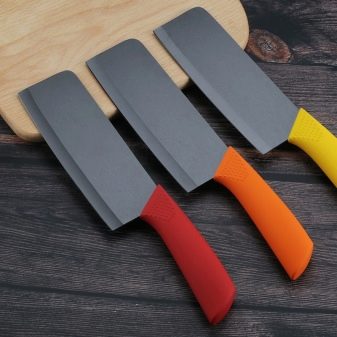
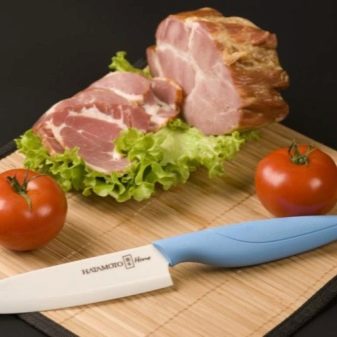
- High carbon stainless steel. Perhaps this is the perfect option for a blade. This material is durable and quite elastic. In most cases, it is used for the manufacture of boning and butcher knives. Steel is able to withstand strong shocks and loads. In this case, the sharpness of the blade remains at height. Flexibility allows you to easily separate the meat from the bone. In this case, you will not need to be afraid that it will break when the blade is bent. Corrosion-resistant properties of steel are determined by the presence of hydrogen.
The higher this indicator, the longer the knife will not rust.

- Titanium. Material has become quite popular not so long ago. And he has his fans, but there are also enough people who don’t like knives. Titanium is not as durable as steel. But this is not so critical. Frequent use makes the blade dull quickly. To grind it at home, like an ordinary knife, is almost impossible. Have to resort to the services of specialists. Another disadvantage is the high cost of such knives.
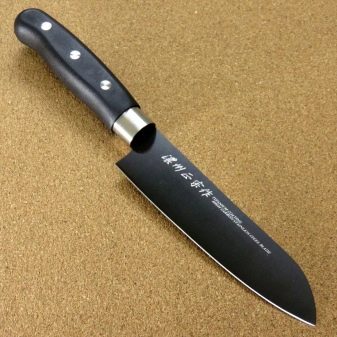

- Damascus steel. It is valued worldwide for its unprecedented high strength. A feature of this type of steel is the use of several alloys in the manufacture of the blade. The most durable will be refined damask steel. It is made from a uniform piece, and all other impurities are removed during smelting. Another view is the welding view. With this manufacturing method, several types of steel with different carbon contents will be combined in one blade. Damascus steel is pretty easy to learn. Its surface is heterogeneous. It can have beautiful stains and splashes.

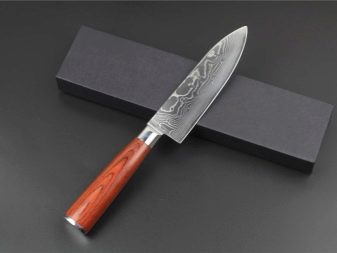
The material from which the blade is made has a key role in choosing a knife. But there are several other factors to consider.
- Handle material. In meat knives it is better to choose handles made of wood or plastic.
- Ergonomic handle. The knife should lie well in the hand. In this case, it will be a pleasure to work with him.
- Price. You should not choose cheap options.Quality materials cannot be cheap. But very expensive copies are also not worth buying. This is a kitchen tool, not a piece of art.
- The form. You can buy a whole set of knives for the purpose, or you can get by with two, if you correctly approach the choice.
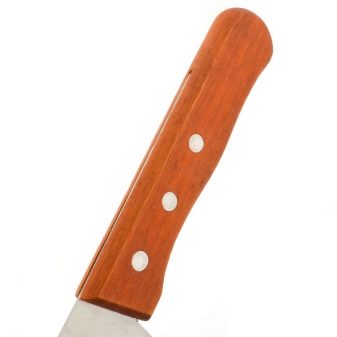

Recommendations for use
Currently, there is a wide variety of knives. Each housewife independently decides whether she will have one universal tool for working with meat, or to purchase a separate one for each type of work. In the first case, you can significantly save on the purchase. After all, together with three or five knives, you get one. Moreover, he copes well with all tasks. But it is worth noting that Frequent use (especially for different purposes) can quickly dull, spoil, or simply wear the product.
As a result, you still have to go to the store for a new knife.
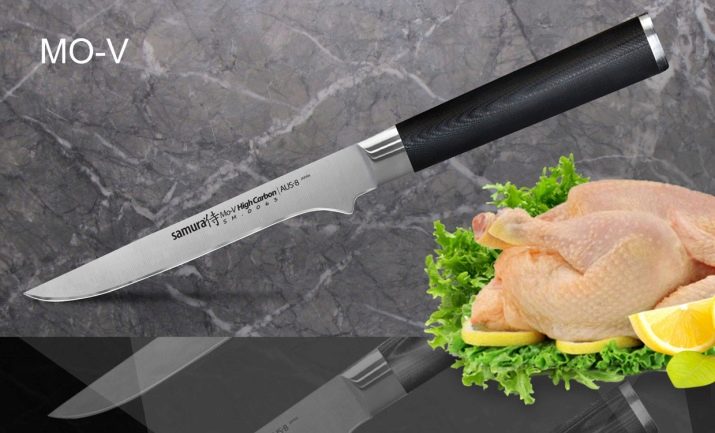
In the second case, it will be necessary to lay out a large amount for the purchase of several knives at once. But they will serve you much longer. After all, a boning knife will serve only for cutting meat, and a cleaver for cutting large pieces and frozen meat. At the same time, universal or loin will wait in the wings. There will be no additional load on any product. And it is quite possible, with such a careful and rational attitude, the products will last you much longer than even the manufacturer himself promises. There are some more unspoken rules when working with knives.
- Use the meat knife for its intended purpose only. For slicing sausages, cheeses, vegetables and fruits, purchase individual copies.
- Only cut on wooden or plastic chopping boards. It will be easier to change the board in a year than to buy a new knife, the blade of which will be damaged on a glass or marble surface.

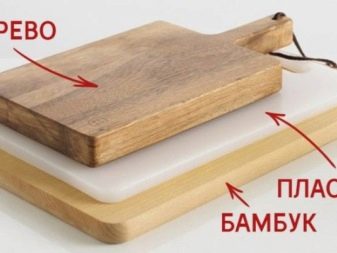
Storage and care
Competent and gentle care of knives can several times extend the life of their operation. It’s not difficult to do this. It is worth remembering only a few basic rules, and your knives will delight you with their excellent appearance and excellent cutting abilities for a long time.
- Products with a wooden handle must not be stored in damp. Also, do not allow prolonged contact with water. After washing, it is better to immediately wipe the handle and blade.
- Meat knives are recommended to be washed manually. Therefore, do not rush to put them in the dishwasher.
- When washing, it is necessary to clean not only the blade itself, but also the handle in order to get rid of dangerous microbes.
- Dry the knives thoroughly with a towel. Water adversely affects both the blade and the handle, as well as the connecting elements.

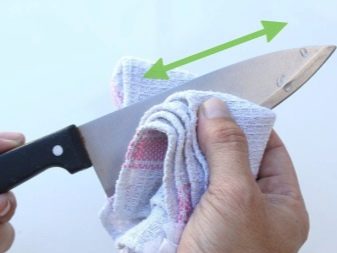
You can buy a whole set of knives, and none of them will suit you. The choice must be approached deliberately, then the subject will serve you for a long time and will be pleasant and convenient to use.
See how to choose kitchen knives in the next video.
